

2019 April 28
The ocean is more than just a hue of blue; it runs a gamut of greens to grays and everything in between. The MODIS intrument on NASA’s Aqua satellite recently acquired this image (click to enlarge) showing swirls of color in the Arabian Sea. The range of ocean colors represents various types of activity occurring in the waters. For instance, different kinds of sediment from a variety of soils, rock types, and organic debris can flow into the ocean and color the water many shades near the shore. Water color can also be affected by the presence of phytoplankton, plant-like organisms that serve as the center of the aquatic food web. MODIS was built by Raytheon in Santa Barbara, Calif. Image and caption courtesy of NASA
(DEC 28) Vandenberg Air Force Base, Calif. – The United Launch Alliance Delta IV Heavy carrying the NROL-71 mission will launch no earlier than Sunday, Jan. 6, 2019. The mission will launch from Space Launch Complex-6 at Vandenberg Air Force Base in California
United Launch Alliance
(DEC 20) Vandenberg Air Force Base, Calif. – The launch of a United Launch Alliance Delta IV Heavy carrying the NROL-71 mission for the National Reconnaissance Office was scrubbed yesterday due to indications of elevated hydrogen concentrations within the port booster engine section.
The team is currently reviewing all data and has set the next launch attempt no earlier than Dec. 30, 2018.
United Launch Alliance
(DEC 19) Vandenberg Air Force Base, Calif. – The launch of a United Launch Alliance Delta IV Heavy carrying the NROL-71 mission for the National Reconnaissance Office was scrubbed today due to indications of elevated hydrogen concentrations within the port booster engine section.
The team is prepping for a 24-hour turn around on Thursday, Dec. 20, from Space Launch Complex-6 at Vandenberg Air Force Base. The forecast shows a 80 percent chance of favorable weather conditions for launch. The launch is planned for 5:31 p.m. PST.
United Launch Alliance
(DEC 18) Vandenberg Air Force Base, Calif. – The launch of a United Launch Alliance Delta IV Heavy carrying the NROL-71 payload for the National Reconnaissance Office was scrubbed today due to high ground winds.
The next launch attempt is planned for Wed., Dec. 19, from Space Launch Complex-6 at Vandenberg Air Force Base, Calif. The forecast indicates an 80 percent chance of favorable weather conditions for launch. The targeted launch time is 5:44 p.m. PST.United Launch Alliance
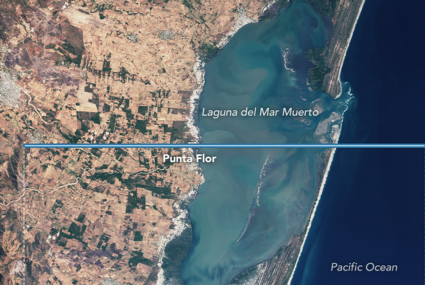
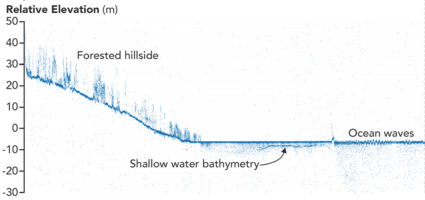
Researchers recently released early results from NASA's IceSat-2 height-measuring mission. The above sample shows an elevation profile of a portion of Mexico's Pacific coast created by plotting the reflected energy from laser pulses directed earthward. The plot shows the heights of the trees and floor of a forest, the surface and bottom of a bay, and ocean waves. IceSat-2 was launched from Vandenberg AFB last September. Image courtesy of the NASA Earth Observatory/Joshua Stevens
(DEC 13) Vandenberg Air Force Base, Calif. – A United Launch Alliance Delta IV Heavy carrying the NROL-71 mission for the National Reconnaissance Office is set to launch on Tuesday, Dec. 18. The mission will lift off on a Delta IV Heavy launch vehicle from Space Launch Complex-6 at Vandenberg Air Force Base in California. The launch time is 5:57 p.m. PST.
United Launch Alliance
(DEC 7) Vandenberg Air Force Base, Calif. – The launch of a United Launch Alliance Delta IV Heavy carrying the NROL-71 mission for the National Reconnaissance Office was scrubbed today due to an issue with a redundant communication link between the control center and the launch site.
The team is prepping for a 24-hour turn around on Saturday, Dec. 8, from Space Launch Complex-6 at Vandenberg Air Force Base. The forecast shows a 60 percent chance of favorable weather conditions for launch. The launch time is 8:06 p.m. PT.
United Launch Alliance
(DEC 3) VANDENBERG AIR FORCE BASE, Calif. - Team Vandenberg is scheduled to support the launch of a United Launch Alliance Delta IV Heavy rocket carrying a National Reconnaissance Office payload from Space Launch Complex-6 on Friday, Dec. 7, with a launch window opening at 8:19 p.m. PST.
Col. Bob Reeves, 30th Space Vice Wing commander, will be the space launch commander.
"Team V has put in a lot of hard work for this launch," said Reeves. "We are dedicated to mission success and proud to work alongside United Launch Alliance and the National Reconnaissance Office."
The 4th Space Launch Squadron executes integrated launch operations with a focus on mission assurance for this spacelift mission.
"Every mission is unique and this Delta IV Heavy launch is a prime example of teamwork with a laser focus on mission success," said Lt. Col. Kenneth Decker, 4th SLS commander and Air Force Launch Director for the mission. "Our mission assurance technicians and engineers have worked diligently with United Launch Alliance and the other mission partners to reduce risk in order to assure mission safety and security. The men and women of the 4 SLS are proud to contribute to this important mission."
Vandenberg AFB
(DEC 3) A Falcon 9 rocket carrying numerous small satellites was launched from Vandenberg AFB this morning at 10:34 PST.
Brian Webb
(DEC 2) Today's planned launch of a Falcon 9 rocket from Vandenberg AFB has been delayed 24 hours. Liftoff is now set for December 3 at 10:31:47 a.m. PST, the start of a 30-minute launch window. Today's launch attempt was postponed to allow for additional inspections of the rocket's second stage.
Brian Webb
(NOV 29) Vandenberg Air Force Base, Calif. - Team V is scheduled to support launch of the Spaceflight SSO-A: SmallSat Express on a SpaceX Falcon 9 rocket from Space Launch Complex-4E on Sunday, Dec. 2, with a launch window of 10:32 a.m. PST to 11:01 a.m. PST.
The public can view this launch from the Hawk's Nest on Azalea Lane off of Hwy 1 just a half mile south of Vandenberg Air Force Base's main gate.
The Hawk's Nest gates will open on Sunday at 9:00 a.m. PST and close at 10:15 a.m. PST. As a reminder the public is asked not to bring or consume alcohol, smoke, nor have any open fires or barbecues. Weapons are not allowed, additionally, the use of small unmanned aerial systems within five miles of any active runway, such as Vandenberg’s, is prohibited.
Vandenberg AFB
(NOV 21) The Boeing Co., El Segundo, California, has been awarded a $13,965,639 modification for the Wideband Global Satellite (WGS) communication system, mitigation and anti-jam effort and additional strings. This effort will provide the WGS system with increased resilience. Work will be performed in El Segundo, California; and Colorado Springs, Colorado, and is expected to be completed by Feb. 28, 2021. Fiscal 2018 research, development, test and evaluation funds in the amount of $13,965,639 are being obligated at the time of award. Space and Missile Systems Center, Los Angeles Air Force Base, California, is the contracting activity.
Department of Defense
(NOV 17) The November 19 launch of a Falcon 9 rocket from Vandenberg AFB has been delayed to allow SpaceX to conduct additional pre-flight inspections. A new launch date has not been announced.
Brian Webb
(NOV 7) A media outlet reports a Minuteman III ICBM was launched from Vandenberg AFB last night (November 6) at 11:01 p.m. Liftoff took place at the start of a six-hour launch window.
Brian Webb
Ventura, Calif. and surrounding areas are visible in this Terra satellite ASTER instrument image (click to enlarge) released on October 31. With its 14 spectral bands from the visible to the thermal infrared wavelength region and its high spatial resolution of about 50 to 300 feet (15 to 90 meters), ASTER images Earth to map and monitor the changing surface of our planet. ASTER is one of five Earth-observing instruments launched on Terra in 1999 from Vandenberg AFB. Image credit: NASA/METI/AIST/Japan Space Systems, and U.S./Japan ASTER Science Team
(NOV 1) NASA's Solar Dynamics Observatory is monitoring a large hole in the sun's atmosphere, now directly facing Earth. A stream of solar wind escaping from the opening is expected to reach our planet during the late hours of Nov. 3rd, likely sparking minor G1-class geomagnetic storms over the weekend.
www.spaceweather.com
(OCT 24) United Launch Services, Centennial, Colorado, has been awarded a $152,429,417 firm-fixed-price contract for Evolved Expendable Launch Vehicle Delta IV heavy launch services. This contract provides launch vehicle production services for National Reconnaissance Office Launch Mission One. Work will be performed in Centennial, Colorado; and Decatur, Alabama, and the launch will occur in Cape Canaveral Air Force Station, Florida; or Vandenberg Air Force Base, California. The work is expected to be completed by June 30, 2021. This award is the result of a sole-source acquisition. Fiscal 2018 missile procurement funds in the amount of $152,429,417 are being obligated at the time of award. Space and Missile Systems Center Los Angeles Air Force Station, California, is the contracting activity.
Department of Defense
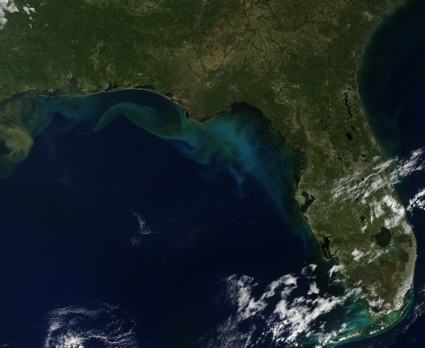
This newly released image from NASA’s Aqua satellite shows the Gulf of Mexico three days after Hurricane Michael passed over the Florida Panhandle. Large tan-and-teal discoloration marks seafloor sediment, river outflows, and coastal sediment washed offshore in the aftermath of Michael’s strong winds, storm surge, and wave action. This view is one of numerous interesting images returned by Aqua since its launch from Vandenberg AFB, Calif. in 2002. Image courtesy of NASA
(OCT 20) A stange object recently discovered on a farm in Hanford, Calif. has been identified as part of a satellite launched from the Golden State two decades earlier.
A farmer strolling through his walnut orchard discovered the charrred, helmet-shaped pice of metal, which was later identified as a fuel tank from the Iridium 70 communications satellite.
A Delta II rocket launched Iridium 70 and four other Iridium satellites from Vandenberg AFB, Calif. on May 17, 1998.
The debris was slated to be sent to Iridium headquarters for analysis.
Brian Webb
(OCT 12) Nineteen years after launch from Vandenberg AFB, a U.S. environmental satellite reaches its end of life. More
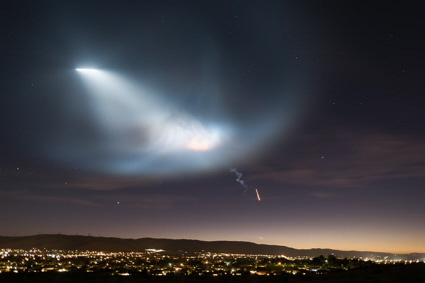
A Falcon 9 rocket lights up the sky following liftoff from Vandenberg AFB on the evening of October 7. David Wilkins recorded this image of the launch from Lancaster, Calif. The orange streak in the lower right is the first stage returning to the launch site. Copyright 2018, David Wilkins. Used with permission
(OCT 7) A Falcon 9 rocket carrying an Argentine satellite was launched at 19:21 PDT this evening from Vandenberg AFB, Calif. The dusk launch created a spectacular display visible over a wide area as the rocket's exhaust was illuminated by sunlight at high altitude.
Brian Webb
(OCT 3) VANDENBERG AIR FORCE BASE, Calif. - The SpaceX Falcon 9 rocket carrying the SAOCOM 1A satellite from Space Launch Complex-4, is delayed to complete pre-flight vehicle checkouts; the rocket and payload are healthy.
The launch is rescheduled for Sunday, Oct. 7, at 7:21 p.m. PDT.
SpaceX is attempting the secondary mission of landing the first stage of the Falcon 9 rocket at Landing Zone 4, which was previously called SLC-4W, at Vandenberg Air Force Base. This will be SpaceX's first land landing attempt at Vandenberg Air Force Base.
The public can view this launch from the Hawk's Nest on Azalea Lane off of Hwy 1 just a half mile south of Vandenberg Air Force Base's main gate.
The Hawk's Nest gates will open on Sunday at 5:00 p.m. PDT and close at 7:10 p.m. PDT. As a reminder the public is asked not to bring or consume alcohol, smoke, nor have any open fires or barbeques. Do not bring any pets. RVs and campers are also prohibited. Weapons are not allowed, additionally, the use of small unmanned aerial systems within five miles of any active runway, such as Vandenberg's, is prohibited.
For more information regarding the launch or public viewing locations, go to our Facebook page at https://www.facebook.com/30thSpaceWing/ or contact 30th Space Wing Public Affairs at (805) 606-3595.
Vandenberg AFB
(SEP 27) United Launch Services, Centennial, Colorado, has been awarded an $867,081,864 cost-plus-incentive-fee, cost-plus-fixed-fee, firm-fixed-price modification (P00199) to contract FA8811-13-C-0003 for Evolved Expendable Launch Vehicle launch capability for the Delta IV and Atlas V families of launch vehicles. The contract modification is for mission integration, base and range support, maintenance commodities, Delta depreciation, and Atlas depreciation and provides for mission assurance, program management, systems engineering, and integration of the space vehicle with the launch vehicle, launch site and range operations, and launch infrastructure maintenance and sustainment. Work will be performed in Centennial, Colorado; Vandenberg Air Force Base, California; and Cape Canaveral Air Station, Florida, and is expected to be completed by Sept. 30, 2019. Fiscal 2018 space procurement funds are being obligated at the time of award. Total cumulative face value of the contract is $9,769,473,249. Space and Missile Systems Center, Los Angeles Air Force Base, California, is the contracting activity.
Department of Defense
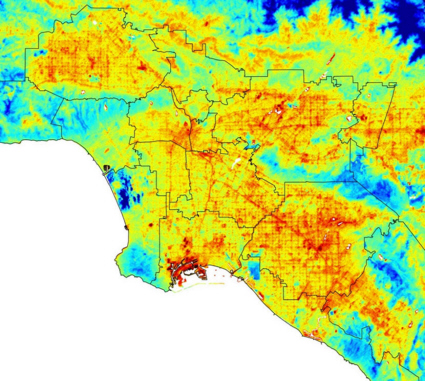
Surface temperature variations in Los Angeles, CA in the early morning hours of July 22 are visible in this image from the International Space Station. The view was recorded by ECOSTRESS, an instrument built and managed by the Jet Propulsion Laboratory in Pasadena, Calif. Hot areas are shown in red, warm areas in orange and yellow, and cooler areas in blue. Credit: NASA/JPL-Caltech
(SEP 17) TUCSON, Ariz. — Every year throughout its 4.5-billion-year life, ice volcanoes on the dwarf planet Ceres generate enough material on average to fill a movie theater, according to a new study led by the University of Arizona. More
(SEP 15) Vandenberg Air Force Base, Calif. – A United Launch Alliance (ULA) Delta II rocket carrying NASA’s Ice, Cloud and land Elevation Satellite-2 (ICESat-2) spacecraft lifted off from Space Launch Complex-2 on Sept. 15 at 6:02 a.m. PDT. This marks the final mission of the Delta II rocket, which first launched on Feb. 14, 1989, and launched 155 times including ICESat-2.
ICESat-2 will provide scientists with height measurements to create a global portrait of Earth’s third dimension, gathering data that can precisely track changes of terrain including glaciers, sea ice, forests and more. Northrop Grumman built the spacecraft. In addition to ICESat-2, this mission included four CubeSats which launched from dispensers mounted to the Delta II second stage.
This mission launched aboard a Delta II 7420-10 configuration rocket, which included a 10-foot-diameter payload fairing (PLF). The booster for this mission was powered by the RS-27A engine and the second stage was powered by the AJ10-118K engine.
This is ULA’s seventh launch in 2018 and the 130th successful launch since the company was formed in December 2006.
United Launch Alliance

The Namib Sand Sea on Africa's southwest coast stands out in striking detail in this Landsat 8 image released this week. It is one of many impressive images transmitted by the spacecraft since its 2013 launch from Vandenberg AFB, Calif. Image courtesy of NASA GSFC
(SEP 9) A Delta II rocket carrying a NASA satellite is scheduled for launch from Vandenberg AFB, California next Saturday morning (September 15) during a 05:46-06:26 PDT launch window. More
(AUG 28) Ambitious climbers, forget Mt. Everest. More
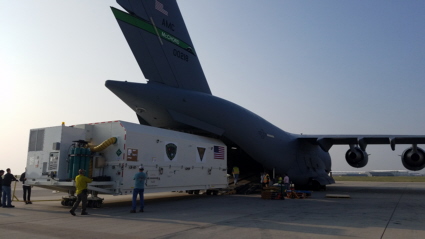
The first GPS III series satellite is loaded aboard a C-17 cargo plane on Aug. 20 at Buckley AFB, Colorado for transport to Titusville, Florida to begin processing for a December launch from Cape Canaveral. The spacecraft was built at the Lockheed Martin factory in Waterton, Colorado and features better accuracy and improved anti-jamming capabilities. The satellite's new L1C civil signal also will make it the first GPS satellite to be interoperable with other international global navigation satellite systems. U.S. Air Force photo by Lt. Col. Erin Gulden
(AUG 20) In the darkest and coldest parts of its polar regions, a team of scientists has directly observed definitive evidence of water ice on the Moon's surface. More
(AUG 14) Lockheed Martin Space Systems, Sunnyvale, California, has been awarded a $2,935,545,188 not-to-exceed undefinitized contract for three Next Generation Overhead Persistent Infrared Geosynchronous Earth Orbit Space Vehicles. This contract encompasses requirements analysis, design/development, critical path flight hardware procurement, early manufacturing, and risk reduction efforts leading to a system critical design review. Work will be performed in Sunnyvale, California, and is expected to be completed by April 30, 2021. This award is the result of a sole-source acquisition and is not a multiyear contract. Fiscal 2018 research, development, test and evaluation funds in the amount of $80,000,000 are being obligated at the time of award. Space and Missile Systems Center, Los Angeles Air Force Base, California, is the contracting activity.
Department of Defense
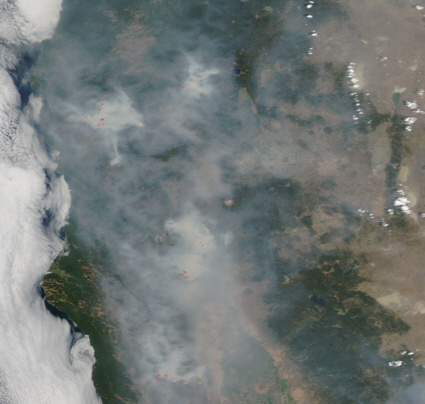
Northern California lies shrouded in smoke from multiple fires in this Aqua spacecraft image taken on August 9. The view was recorded by the spacecraft's MODIS instrument during a daylight pass over the region and is one of many interesting images provided Aqua since its launch from Vandenberg AFB, Calif. in 2002. Image Credit: Jeff Schmaltz, MODIS Land Rapid Response Team, NASA GSFC
(AUG 9) WASHINGTON - The Defense Department will establish a sixth branch of the armed forces, the U.S. Department of the Space Force, by 2020, Vice President Mike Pence announced today. More
(JUL 31) A Minuteman III missile was launched early this morning from Vandenberg AFB. An anomaly occured during flight and a command was sent to the vehicle at 4:42 a.m. to self destruct.
For details, go to:
Minuteman III Missile Test Launch from Vandenberg AFB Ends in Failure
Brian Webb
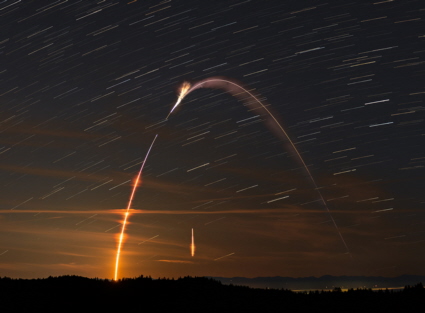
The flame from a Falcon 9 rocket traces an arc across the sky following liftoff from Vandenberg AFB on the morning of July 25. Craig Z. Foster recorded the event by taking 14 30-second exposures from the Santa Cruz Mountains 180 miles north-northwest of the launch site and stacking them to create a composite image. Also visible is the braking burn from the spent first stage (vertical orange streak) prior to landing. Image copyright 2018, Craig Z. Foster. Used with permission
(JUL 25) On Wednesday, July 25, 2018 at 4:39 a.m. PDT, SpaceX successfully launched ten Iridium NEXT satellites from Space Launch Complex 4E (SLC-4E) at Vandenberg Air Force Base in California. This was the seventh set of satellites in a series of 75 total satellites that SpaceX will launch for Iridium’s next generation global satellite constellation, Iridium® NEXT. The satellites began deployment about an hour after launch.
Following stage separation, SpaceX successfully landed Falcon 9’s first stage on the “Just the Read the Instructions” droneship in the Pacific Ocean.
SpaceX
(JUL 19) Vandenberg Air Force Base, CA -- VANDENBERG AIR FORCE BASE, Calif. – The Joint Space Operations Center transitioned to a Combined Space Operations Center during a ceremony at Vandenberg Air Force Base, July 18, 2018.
In 2017, Air Force Gen. John Hyten, U.S. Strategic Command commander, directed the transition. It is designed to improve coordination between the U.S., its allies, and commercial and civil partners for defensive space efforts. It will enhance individual and collective space capabilities in order to expand the overall multi-domain military effectiveness.
The CSpOC ensures the combined space enterprise meets and outpaces emerging and advancing space threats. Conducting operations with allies and partners will improve space mission assurance, resilience and mutual security, broaden military relationships by leveraging capabilities, maximize effectiveness across all mission areas, and expand international partnerships in support of combined objectives.
The CSpOC will provide input to develop and improve the ability to rapidly detect, warn, characterize, attribute, and defend against disturbances to space systems. The center will help to increase the resilience of the combined space enterprise and support the delivery of space-based capabilities for allies, partners and other responsible space-faring nations. These space capabilities allow decision makers to see the battlespace with clarity, strike with precision, navigate with accuracy, communicate with certainty, and operate with assurance over global distances.
Some missions the CSpOC will be responsible for directing are missile warning; positioning, navigation and timing; optimization and restoration of military satellite communications; theater battlespace awareness using overhead persistent infrared; environmental monitoring; theater support fires; defensive space situational awareness and space defense.
Space is a warfighting domain, just like air, land, maritime and cyber. Strong partnerships are vital to tempering the would-be designs of those who might attack other nations. The CSpOC positions the U.S. and allied space forces to deter conflict from extending into, or starting in space; and, should deterrence fail, to fight and win.
U.S. Joint Force Space Component Command
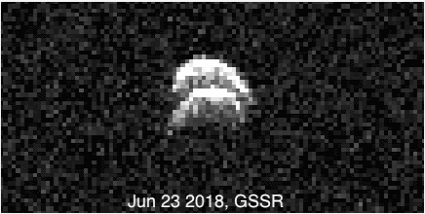
This recently released image of asteroid 2017 YE5 from NASA's Goldstone, Calif. radar provided the first evidence the object consists of two bodies. The image was collected in late June when the asteroid made a close pass by Earth. Image courtesy of GSSR/NASA/JPL-Caltech
(JUL 9) SACRAMENTO, Calif. – Aerojet Rocketdyne recently passed a key milestone in preparation for the Ascent Abort Test (AA-2) next year with the successful casting of the Jettison Motor for the Lockheed Martin-built Orion spacecraft’s Launch Abort System (LAS).
AA-2 is a full-stress test of NASA’s Orion LAS, which includes the Jettison Motor built by Aerojet Rocketdyne. The Orion Jettison Motor is used to separate the LAS from Orion as it makes its way to space and is the only motor on the escape system to activate in all mission scenarios.
In the unlikely event of an emergency on the launch pad or during ascent, the LAS would activate within milliseconds to whisk Orion and its astronaut crew to safety. Once Orion reaches a safe distance from the rocket, the Orion Jettison Motor would ignite to separate the LAS structure from the spacecraft, which could then deploy its parachutes for a safe landing.
During the AA-2 test, a solid rocket booster will launch a fully functional LAS and an Orion test vehicle to an altitude of 31,000 feet at Mach 1.3 (over 1,000 mph) to test out the functionality of the LAS system prior to flying humans. The Jettison Motor will fire last in the test sequence.
“Every time our engineers work on products supporting the Orion spacecraft or the Space Launch System rocket, they have astronaut safety front and center of mind,” said Aerojet Rocketdyne CEO and President Eileen Drake. “The AA-2 test is a critical step to testing the Launch Abort System and our Jettison Motor and ensuring our astronauts always return home safely to their families.”
The Orion Jettison Motor, which generates 40,000 pounds of thrust, uses a propellant that is poured into a motor casing, where it cures over a period of several days to form a solid, stable cast that burns in a precisely controlled fashion.
The AA-2 Jettison Motor casting took place at Aerojet Rocketdyne’s motor production facility in Sacramento, California. The completed motor will now be shipped to NASA’s Kennedy Space Center for integration with the LAS by Lockheed Martin.
Aerojet Rocketdyne
(JUL 2) The laser ranging interferometer (LRI) instrument has been successfully switched on aboard the recently launched twin U.S./German Gravity Recovery and Climate Experiment Follow-On (GRACE-FO) satellites. More
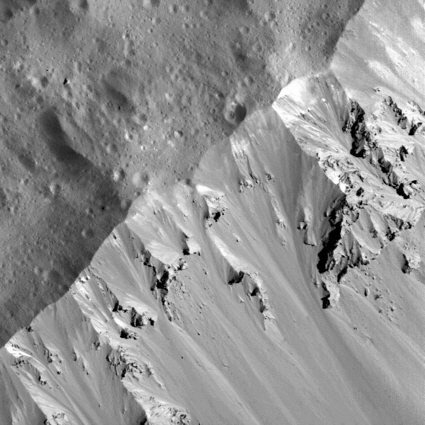
Abundant detail is visible in this recent Dawn spacecraft image of the asteroid Ceres released by the Jet Propulsion Laboratory (JPL) in Pasadena, Calif. This view shows the northern wall of Occator crater and was taken from an altitude of about 21 miles (33 kilometers) as Dawn orbited Ceres. Dawn's mission is managed by JPL for NASA's Science Mission Directorate. Image courtesy of JPL
(JUN 28) NEWARK, N.J. - A solar telescope that captures images of the entire disk of the Sun, monitoring eruptions taking place simultaneously in different magnetic fields in both the photosphere and chromosphere, is now being installed beside the Goode Solar Telescope (GST) at NJIT’s California-based Big Bear Solar Observatory (BBSO). More
(JUN 21) LOS ANGELES AIR FORCE BASE, El Segundo, Calif. -- The Air Force has announced the award of an Evolved Expendable Launch Vehicle (EELV) launch service contract. Space Exploration Technologies Corporation (SpaceX) has been awarded a $130 million firm-fixed price contract for launch services to deliver Air Force Space Command (AFSPC)-52 satellite to the intended orbit. The contract provides the Government with a total launch solution for this mission, which includes launch vehicle production, mission integration and launch operations. This mission is planned to be launched from Kennedy Space Center, Florida.
This is the fifth competitive procurement under the current Phase 1A strategy. These launch service contract awards strike a balance between meeting operational needs and lowering launch costs through reintroducing competition for National Security Space missions.
“The competitive award of this EELV launch service contract directly supports Space and Missile Systems Center’s (SMC) mission of delivering resilient and affordable space capabilities to our Nation while maintaining assured access to space,” said Lt Gen John F. Thompson, Air Force program executive officer for Space and SMC commander.
AFSPC-52 is a classified mission projected to launch in late Fiscal Year 2020.
The Air Force Space Command's Space and Missile Systems Center, located at the Los Angeles Air Force Base, California, is the U.S. Air Force's center of excellence for acquiring and developing military space systems. Its portfolio includes the Global Positioning System, military satellite communications, defense meteorological satellites, space launch and range systems, satellite control networks, space based infrared systems, and space situational awareness capabilities.
Los Angeles Air Force Base
(JUN 17) Earth-based observers may be able to see an ogoing martian dust storm without a telescope. If the storm grows and intensifies, naked-eye observers may see the normally orange-red Mars take on a dusky yellow color. To find Mars, go outside just before dawn and look towards the south. The planet should be shining brightly at magnitude -1.7 approximately 35 degrees above the horizon.
Brian Webb

The southern tip of South America, also known as Patagonia, displays a mix of mountains and plains in this true-color NASA Aqua satellite image acquired on June 3. Aqua was launched from California’s Vandenberg AFB in 2002. Image Credit: Jeff Schmaltz, MODIS Land Rapid Response Team, NASA GSFC
(JUN 7) PASADENA, Calif. - NASA's Curiosity rover has found new evidence preserved in rocks on Mars that suggests the planet could have supported ancient life, as well as new evidence in the Martian atmosphere that relates to the search for current life on the Red Planet. More
(MAY 25) WASHINGTON, D.C. - NASA has exercised options under the Rapid Spacecraft Acquisition III (Rapid III) contractfor two additional Joint Polar Satellite System (JPSS) spacecraft to be built for the National Oceanic and Atmospheric Administration (NOAA).
Orbital ATK of Dulles, Virginia, will build NOAA’s Joint Polar Satellite System JPSS-3 and -4. The contract value is $460 millionand the period of performance will extend through 2026. The work will be performed at Orbital ATK’s facility in Gilbert, Arizona.
Orbital, which currently is developing the JPSS-2 spacecraft, will design, develop, fabricate, integrate, test and provide post-delivery support for the third and fourth spacecraft in the series.
JPSS satellites collect global, multi-spectral radiometry and other specialized meteorological, oceanographic data via remote sensing of land, sea and atmospheric properties. These data support NOAA’s mission for continuous observation of Earth’s environment to understand and predict changes in weather, climate, oceans and coasts.
NOAA funds the JPSS missions and NASA is the acquisition agent for the flight systems, launch services and components of the ground system.
NASA
(MAY 22) This afternoon's scheduled Falcon 9 rocket launch from Vandenberg AFB took place as planned at 12:47 PDT.
Thus far no launch observations have been received. However, one person reported the launch made his building shake.
Brian Webb

Although spring is well under way, snow covers much of Quebec in this recent image of New England and eastern Canada. NASA's Aqua satellite recorded the scene during a pass over the region on May 13. Aqua was launched aboard a Delta II rocket from Vandenberg AFB, Calif. in 2002. Image Credit: Jeff Schmaltz, MODIS Land Rapid Response Team, NASA GSFC
(MAY 20) A Falcon 9 rocket carrying several satellites is scheduled for launch from south Vandenberg AFB on Tuesday afternoon at 12:47:58 PDT.
Following lift-off, the rocket will climb vertically for several seconds before it begins a gradual turn and heads south. If the launch is successful, the Falcon 9 will place several Iridium NEXT communications satellites and two GRACE Follow-on scientific satellites into orbit.
Weather permitting, the bright orange flame from the rocket's first stage could be visible to the unaided eye as far away as Big Sur, Bakersfield, and Rancho Palos Verdes, Calif.
People in very quiet locations in coastal Santa Barbara and Ventura Counties and the western Santa Monica mountains may hear a distant, muffled rumble from the launch sometime between T+4 and T+12 minutes.
Some launch enthusiasts may be planning gather to watch the event from west of Lompoc near highway 246 (west Ocean Avenue) and Union Sugar Road.
However, if you intend to view the launch near the coast, be advised there is a real possibility the event will be obscured by low clouds or fog.
For the best view in outlying areas, get above the haze or marine layer and find a place with an unobstructed horizon towards the launch site and Channel Islands.
Regardless of where you plan to go to view the launch, allow yourself enough time to get there well before liftoff. After you arrive, be aware of your surroundings and possible hazards such as traffic.
For launch status and countdown information, go to:
For information on viewing Vandenberg rocket and missile launches, go to:
www.spacearchive.info/vafbview.htm
The Internet countdown feed may be delayed by several seconds. Rather than relying on the feed for launch cueing, use a GPS receiver or another source to obtain the exact time. You can also set your watch to the exact time from the National Institute of Standards and Technology (www.time.gov).
Brian Webb
(MAY 14) Media sources report this morning's scheduled Minuteman III missile launch from Vandenberg AFB took place at 01:23 PDT.
Thus far no launch observations have been received.
Brian Webb
(MAY 13) According to Central Coast news outlets, a Minuteman III missile is scheduled for launch from Vandenberg AFB on the morning May 14 during a 01:21 to 07:21 launch window.
Following liftoff, the vehicle will head west and send a mock warhead on a ballistic (non-orbital) trajectory to an impact area in the central Pacific.
If the sky is clear, the event could be visible as far away as southern Oregon, western Arizona, and northern Baja California.
Brian Webb
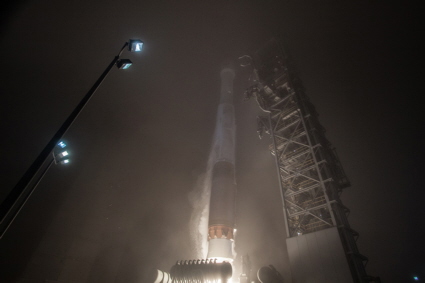
A ULA Atlas V rocket carrying NASA's Mars InSight mission lifts off from Vandenberg AFB, Calif. on May 5. United Launch Alliance photo
(MAY 5) A United Launch Alliance (ULA) Atlas V rocket carrying NASA’s InSight Mars lander lifted off from Space Launch Complex-3 on May 5 at 4:05 a.m. PDT . InSight is the first mission launched to another planet from the West Coast, which requires more energy than an East Coast launch that takes advantage of the Earth’s rotation. The West Coast Mars launch was made possible by the performance of the Atlas V and an optimized trajectory design to achieve the very exact hyperbolic injection required to deliver the spacecraft to Mars.
In addition to InSight, the mission included two CubeSats which launched from dispensers mounted on the aft bulkhead carrier on the Atlas V Centaur second stage.
The Mars Cube One (MarCO) CubeSats, designed and built by the Jet Propulsion Laboratory, are the first to travel interplanetary.
This mission was launched aboard an Atlas V 401 configuration vehicle, which includes a 4-meter Payload Fairing (PLF). The Atlas booster for this mission was powered by the RD AMROSS RD-180 engine. Aerojet Rocketdyne provided the RL10C-1 engine for the Centaur upper stage.
This is the 78th launch of the Atlas V rocket, ULA’s fifth launch in 2018 and the 128th successful launch since the company was formed in December 2006.
United Launch Alliance
(APR 25) According to media reports, this morning's scheduled launch of a Minuteman III took place at 05:26 PDT.
Few people apparently saw the event or the sunlit launch aftermath at dawn due to widespread coastal low clouds and fog.
Brian Webb
(APR 18) COLORADO SPRINGS, Colo. -- Raytheon Company (NYSE: RTN) has built two small, Polar Scout satellites for the U.S. Department of Homeland Security in partnership with Millennium Engineering and Integration. The satellites have flexible radio frequency receivers to help search and rescue teams locate emergency beacons in remote areas, such as the Arctic.
Raytheon assembled the small satellites at the company's advanced missile production facility in Tucson, Arizona. The smallsats are part of a project led by the U.S. Air Force Operationally Responsive Space program to show how they can be built efficiently and cost effectively.
"With our automated production lines, Raytheon can produce highly reliable, small satellites quickly and affordably," said Dr. Thomas Bussing, Raytheon Advanced Missile Systems vice president. "Because our advanced manufacturing facilities are flexible, we can build small satellites or satellite components designed by Raytheon or another company."
Small satellites are less expensive and can be produced more quickly than large geostationary satellites. Operating from lower orbits, the smallsats apertures and sensors can meet mission requirements normally accomplished by larger satellites.
"Because of its innovative technology and advanced production facilities, Raytheon has been the ideal partner for this program," said George Moretti, Millennium Engineering and Integration executive director.
In addition to Millennium, Raytheon worked with Rincon Research and Space Dynamics Laboratories to develop and produce the Polar Scout satellites. The smallsats are scheduled to be launched into lower Earth orbit later this year.
Raytheon
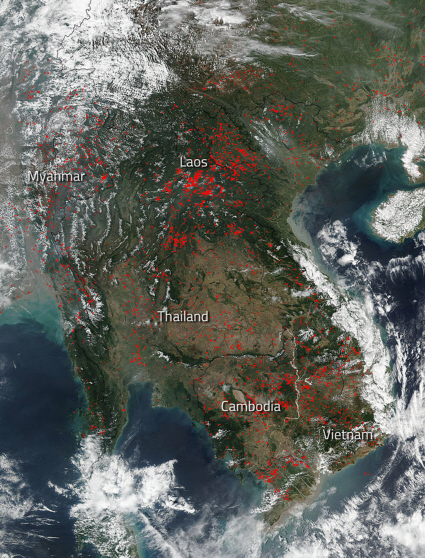
Numerous fires dot Indochina in this image recorded on April 9 by the Suomi NPP satellite. The spacecraft's Visible Infrared Imaging Radiometer Suite (VIIRS) sensor detected 2,370 separate hotspots throughout the region. Most likely these fires are agricultural in nature and were set to clear fields, but some could have been started by lightning or set intentionally and got out of control. Suomi NPP was launched from Vandenberg AFB in 2011. NASA image courtesy Jeff Schmaltz LANCE/EOSDIS MODIS Rapid Response Team, GSFC
(APR 12) PASADENA, Calif. - The ASTERIA satellite, which was deployed into low-Earth orbit in November, is only slightly larger than a box of cereal, but it could be used to help astrophysicists study planets orbiting other stars. More
(APR 7) Virgin Galactic successfully conducted the first supersonic, rocket-powered flight of its SpaceShipTwo VSS Unity spacecraft on April 5.
The WhiteKnightTwo carrier aircraft took off from Mojave, California at 8:20 PDT and climbed to about 46,500 feet above the Sierra Nevada mountains before releasing SpaceShipTwo. Following release, the crew of SpaceShipTwo performed a 30-second burn of its hybrid rocket motor while executing an 80-degree climb.
The maneuver accelerated the spacecraft to a speed of Mach 1.87 and lofted it to a maximum altitude of 84,271 feet. SpaceShipTwo then glided to Mojave, Calif. and made a runway landing.
Brian Webb
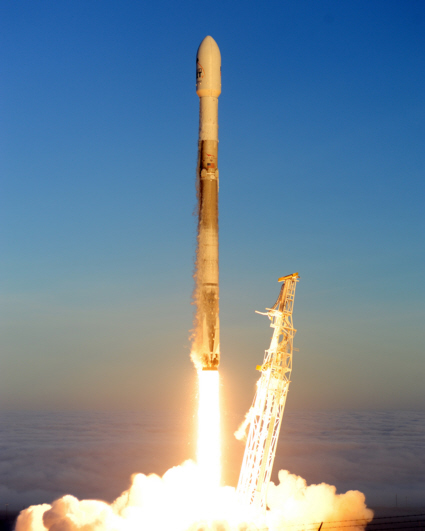
A SpaceX Falcon 9 rocket lifts off from Space Launch Complex-4E at Vandenberg AFB on March 30. U.S. Air Force photo by Airman 1st Class Clayton Wear
(MAR 30) A Falcon 9 rocket carrying several satellites was successfully launched from Vandenberg AFB this morning. The vehicle departed Space Launch Complex 4E on south base at 7:13 a.m. and inserted 10 Iridium NEXT communications satellites into a polar orbit.
Brian Webb
(MAR 14) Space Exploration Technologies Corp., Hawthorne, California, has been awarded a $290,594,130 firm-fixed-price contract for launch services to deliver the GPS III to its intended orbit. This contract provides launch vehicle production, mission integration/launch operations/spaceflight worthiness and mission unique activities for a GPS III mission, with options for two additional GPS III launch services. Work will be performed in Hawthorne, California; Cape Canaveral Air Force Space Station, Florida; and McGregor, Texas, and is expected to be complete by March 2020. This award is the result of a competitive acquisition and two offers were received. Fiscal 2017 and 2018 space procurement funding in the amount of $96,937,905 will be obligated at the time of award. The Contracting Division, Launch Systems Enterprise Directorate, Space and Missile Systems Center, Los Angeles Air Force Base, California is the contracting activity.
Department of Defense
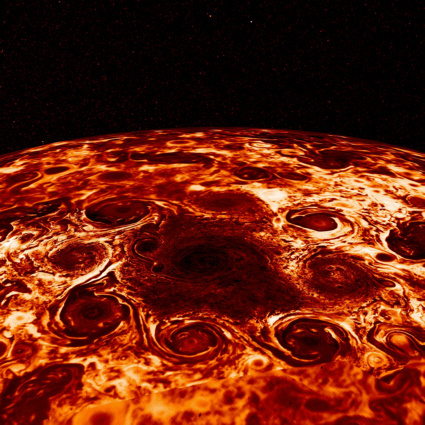
Jupiter's central cyclone at the planet's north pole and the cyclones that encircle it are visible in this infrared image derived from data from NASA's Juno spacecraft. The colors in this composite represent radiant heat: the yellow (thinner) clouds are about 9 degrees Fahrenheit (-13° Celsius) in brightness temperature and the dark red (thickest) are around -181 degrees Fahrenheit (-118.33° Celsius). The Jet Propulsion Laboratory (JPL) in Pasadena, Calif. manages the Juno mission for the principal investigator, Scott Bolton, of Southwest Research Institute in San Antonio. Image credit: NASA/JPL-Caltech/SwRI/ASI/INAF/JIRAM
(MAR 10) The Ventura County Astronomical Society will host a public astronomy lecture from 7:15-9 p.m. on March 16 at the Moorpark College Forum.
Dr. Luisa Rebull of Cal Tech will discuss how anyone can access the vast amount of research-quality astronomy data and interpret it like the pros.
The Moorpark College Forum is located at 7075 Campus Rd, Moorpark, CA 93021. Parking and admission are free.
Brian Webb
(FEB 28) NASA's InSight spacecraft has arrived at Vandenberg Air Force Base in central California to begin final preparations for a launch this May. More
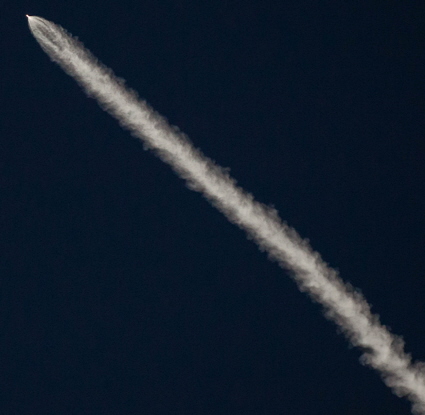
A Falcon 9 rocket carrying Spain's Paz spacecraft and two secondary payloads climbs into the dawn sky on February 22 following liftoff from Vandenberg AFB, Calif. Patti Gutshall took this photo of the event from Santa Barbara using a Nikon D800E camera and zoom lens set to 175mm. Image copyright 2018, Patti Gutshall. Used with permission
(FEB 22) VANDENBERG AIR FORCE BASE, Calif. - Team Vandenberg successfully launched a Falcon 9 rocket carrying a PAZ payload from Space Launch Complex-4 here, Thursday, Feb. 22, at 6:17 a.m. PST.
Col. Greg Wood, 30th Space Wing vice commander, was the space launch commander.
"This launch was a testament to the hard work of Team Vandenberg, SpaceX and Spain," said Wood. "I am proud of everyone involved that continues to pave the way for our nation's access to space."
Vandenberg AFB
(FEB 21) The February 22 launch of a Falcon 9 rocket from Vandenberg AFB could provide an interesting light show visible over a wide area.
The rocket is scheduled to lift off at 06:17 PST during an instantaneous launch window. The Falcon will carry Spain’s Paz earth-imaging satellite and two secondary payloads into a nearly-polar orbit. The window is very short because of the need to precisely position Paz with respect to other spacecraft to form an earth-observation satellite constellation.
Launch occurs about 24 minutes before Vandenberg sunrise. Weather permitting, the Falcon 9’s bright orange flame should be visible in western California at least as far away as San Luis Obispo and Santa Monica.
A computer simulation by Rick Baldridge for a previous launch opportunity shows the rocket will exit the Earth’s shadow and climb into sunlight at about T+2 minutes 10 seconds.
That would make the launch especially interesting as the Falcon 9’s exhaust plume is illuminated by the Sun while suspended in a semi-dark sky. Such a display could be visible from San Francisco to Baja California.
Brian Webb
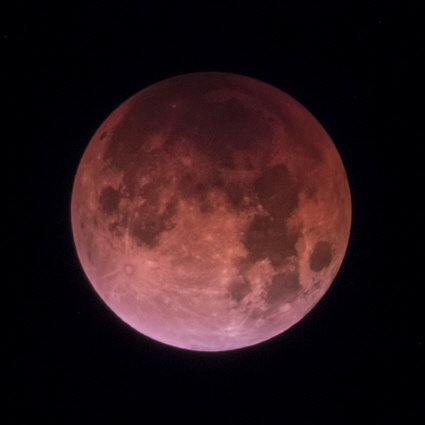
The full moon turns red as it passes through the earth's shadow before sunrise on January 31. Jason Nguyen took this image of the colorful event from his rooftop in Santa Ana, Calif. using a Fuji xt2 camera with a 100-400 lens and 2x teleconverter. Image copyright 2018, Jason Nguyen. Used with permission
(JAN 28) If the weather cooperates, early risers in the Southwest can enjoy a total lunar eclipse on the morning of January 31.
The key times (in Pacific Time) for this event are as follows:
03:48 Partial eclipse begins
04:42 Totality begins
05:30 Mid-eclipse
06:08 Totality ends
07:11 Partial eclipse ends
Experts predict that the normally gray moon will probably be bright orange in color during totality. To see the eclipse, you won't need any special equipment, the unaided eye will suffice. However, you will have a better view if you use binoculars or a small telescope.
Brian Webb
(JAN 21) Sky watchers in parts of California and Mexico may be treated to an interesting dawn light show next month thanks to a rocket launch from Vandenberg Air Force Base. A SpaceX Falcon 9 rocket is slated to lift off from south base no earlier than February 10 and carry Spain’s Paz satellite into orbit.
Liftoff is currently scheduled for 06:22 PST, 31 minutes before sunrise at Vandenberg. Although Falcon 9 night launches are easily visible over a wide area due to the rocket’s brilliant flame, this launch could have an added dimension: The Twilight Effect.
An analysis of lighting conditions by amateur astronomer extraordinaire Rick Baldridge shows if the launch occurs at 06:22 PST on February 10, the rocket will climb out of the Earth’s shadow and into sunlight at T+ 2 minutes 15 seconds.
If this is the case, the launch could be especially interesting as the Falcon 9’s exhaust plume is illuminated by the Sun while suspended in a semi-dark sky. If the sky is clear, such a display could be visible in western California from San Francisco to San Diego and in Baja California.
Brian Webb
(JAN 12) VANDENBERG AIR FORCE BASE, Calif. - Team Vandenberg successfully launched a United Launch Alliance Delta IV rocket carrying a National Reconnaissance Office payload from Space Launch Complex-6 here, Friday, Jan. 12, at 2:11 p.m. PST.
Col. Greg Wood, 30th Space Wing vice commander, was the space launch commander.
"This was an incredibly important launch for the 30th Space Wing and our mission partners," said Wood. "The entire team - the 30th Space Wing, the National Reconnaissance Office, United Launch Alliance, and others - worked hand-in-hand to ensure this launch was safe and successful. This was an outstanding effort by everyone."
This satellite was launched aboard a Delta IV Medium (5,2) configuration Evolved Expendable Launch Vehicle. Established by the U.S. Air Force, the EELV program provides assured access to space for Department of Defense and other government agencies.
Vandenberg AFB
(JAN 11) VANDENBERG AIR FORCE BASE, Calif. - The United Launch Alliance Delta IV rocket carrying a National Reconnaissance Office payload from Space Launch Complex-6, was delayed today due to an issue with a ground system valve.
The launch is rescheduled for Friday, Jan. 12, with a window beginning at 1:00 p.m. PST.
Vandenberg AFB
(JAN 10) Vandenberg Air Force Base, Calif. – The launch of a United Launch Alliance Delta IV carrying the NROL-47 mission was scrubbed today due to high ground winds.
The launch is planned for Thursday, Jan. 11, from Space Launch Complex-6 at Vandenberg Air Force Base. The forecast shows a 90 percent chance of favorable weather conditions for launch. The launch time is 1:00 p.m. PT.
United Launch Alliance

Millions of people along the East Coast of the United States faced snow and ice, gusty winds, power outages, travel delays, school closings, and flooding as a rapidly-intensifying Nor’easter plowed northward during the first week of 2018. The Suomi-NPP spacecraft took this nighttime image of the storm at 10:30 p.m. PST on January 3. In this view, the clouds are lit from above by the nearly full Moon and from below by the lights of the heavily populated East Coast. Suomi-NPP was launched from Vandenberg AFB in October 2011. Image Credit: NASA/NASA Earth Observatory
(JAN 4) LOS ANGELES AIR FORCE BASE, El Segundo, Calif. -The Space and Missile Systems Center and Orbital ATK have signed a Cooperative Research and Development Agreement (CRADA) as part of the company's effort to certify its Next Generation Launcher for National Security Space (NSS) missions. This cooperative agreement facilitates data exchanges and protects proprietary and export-controlled data. The CRADA will be in effect until all non-recurring design validation activities are complete.
The purpose of certification is to provide the Air Force with high confidence that launch providers are capable of meeting launch requirements for NSS missions according to the New Entrant Certification Guide (NECG). Formal design and mission reliability assessments ensure the launch system's ability to provide the necessary payload mass-to-orbit, orbital insertion accuracy and other requirements to place a healthy payload into its intended orbit.
While certification does not guarantee a contract award, it does enable a company to be awarded competitive launch services contracts.
Currently, ULA's Delta IV and Atlas V, and SpaceX's Falcon 9 Upgrade are the only certified launch vehicles for sending NSS payloads into orbit. Having multiple certified launch vehicle providers and multiple families of launch systems bolsters the U.S.' continued assured access to space.
The Space and Missile Systems Center, located at Los Angeles Air Force Base, California, is the U.S. Air Force's center for acquiring and developing military space systems. Its portfolio includes the Global Positioning System, military satellite communications, defense meteorological satellites, space launch and range systems, satellite control networks, space based infrared systems and space situational awareness capabilities.
Air Force Space and Missile Systems Center
Copyright © 2006-2019, Brian Webb. All rights reserved.